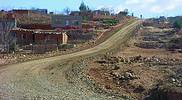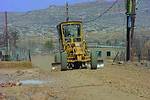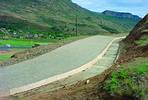Development projects in the Free State
1 August 2004

Harrismith is bustling with activity as the Phuthaditjhaba and Qwa Qwa regions are placed in the spotlight for development projects. The design and implementation of the venture was requested by the Maluti-a-Phofung Municipality in the beginning of 2003 and involves the stormwater management of these areas as well as the construction of a number of gravel distributor roads.
Phuthaditjhaba is located in the north eastern Free State and is bordered by KwaZulu-Natal to the southeast and Lesotho to the southwest. It has a total estimated population of 450 000 individuals and combined with Qwa Qwa, Harrismith and Kestrel, forms part of the Maluti-a-Phofung Municipality in the Thaba Mofutsanyana District Council.
Ninham Shand, Consulting Engineer, was appointed to handle the design and contract management of the project. "The road that we constructed in the Qwa Qwa area is 10,3 km in length, of which 9,70 km include stormwater channels with road crossings," says Rudi Beeslaar from Ninham Shand.

"The Phuthaditjaba area was equally challenging, as we constructed a 12,2 km road and the length of stormwater channels with road crossings was 9,5 km in total. We installed approximately 100 m of stormwater pipes with manholes and outlet structures," explains Beeslaar, illustrating the scope of the project.
The topography of the region ranges from steep mountainous slopes with numerous valleys in the south, to rolling hills in the north, while the existing network of roads vary from tarred roads, to two-wheel tracks.
Interactive engineering design software called Civil Designer was used to design the horizontal and vertical road alignments. "The horizontal alignment was governed by the town-planning layout of the area, while the vertical alignment was designed to follow the topographical features with some adjustments in order to control the stormwater run-offs.

"In terms of stormwater systems, concrete stormwater side drains and road crossings were constructed while stormwater pipes with manholes and outlet structures were created when required."
Landscape problems hampered the development of the Qwa Qwa road, as the houses were built with no formal structure. This presented a great challenge for the design of the road because it had to be woven in-between existing homes and the team often had to work with steep gradients.
According to Beeslaar, the Qwa Qwa ward councils specify firm guidelines in maintaining standards and act as a medium between the community and the developer during the project's completion. The design was completed in accordance with the design criteria as set out by the Maluti-a-Phofung Municipality and in accordance with the 'Guidelines for the Provision of Engineering Services and Amenities in residential township development' manual.
Community reaction on the project was very positive because the undeveloped area was previously inaccessible, making transportation impossible. "With the new road, everyone's lifestyle will improve because people will have the benefit of using taxis, buses and vehicles for transportation to various destinations," explains Beeslaar.
The team at Ninham Shand has supported the government's job creation initiative by ensuring that tasks are as labour intensive as possible. Besides layer works that are completed by machines, the rest of the activities are done by means of manual labour. The Qwa Qwa region is divided into various wards and local workers are used within each ward so that the community can obtain maximum benefit from the project.
In addition to this, material is sourced locally and it is likely that the road paving will be received from Lancaster, a factory in Qwa Qwa that is responsible for the manufacture of bricks. Stormwater pipes will also be sourced locally.
The project has been divided into two phases, with phase one receiving a budget of R1,2 million for the creation of 470 m of paved road with stormwater drainage. Phase two will commence shortly and is expected to receive a budget of R5 million for the completion of the remaining 1,6 km stretch that will include paving as well as storm water systems.
All earthwork calculations are done in Civil Designer before the information is transferred into AllyCAD in order to complete the finishing touches to the design.
For more information contact Yolanda Desai, Knowledge Base Software, 021 701 1850.
Others who read this also read these articles
A challenge for motor manufacturers
Computer-based integration of design and manufacturing is essential for the '24-month car' to be achieved[ October 2004 ]
Prominent new lifestyle centre for Cape Town's financial district
Dimension Modeling created the 3D interior models that were then also rendered out for internal views of the apartments as well as the atrium and foyer areas[ August 2004 ]
Anglo Platinum - automating repetitive design tasks with Solid Edge
Solid Edge Insight is an innovative solution that seamlessly integrates CAD, design management and Web-based collaboration into a single tool that is easy to implement and easy to manage[ June 2004 ]
Styled plastic products and packaging - main pains and solution initiatives
To put the product and the customer front and centre, where they belong, all disciplines must sit at the same virtual table, sharing the same information and seeing the same vision[ June 2004 ]
Evolution from 2D to 3D - a product development manager's perspective: Part II
Whereas 2D CAD shortens time scales to some extent, 3D CAD goes much further, directly supporting the whole product development cycle, speeding up every activity and increasing the quality of design by removing many sources of inaccuracy and error[ April 2004 ]
Multiphysics analysis to simulate cylinder head
Adiabatics Inc used multiphysics FEA software from Algor to study the thermal and structural behaviour of a cylinder head for a diesel engine that would provide reduced heat rejection and increased power density while maintaining its superior fuel economy and lower operating cost[ December 2003 ]
Unigraphics NX 2: the next generation
What the NX 2 release sees is the integration of the use of networks of curves to define surface boundaries and existing geometry, and freeform surface modelling into the core of Unigraphics but with a few rather neat extras as well[ October 2003 ]
Geopak helps create Festival City
Geopak Site allows one to handle with ease live 'what if' scenarios with the client and other design team members[ August 2003 ]
Others who read this also read these news items
Lockheed Martin selects preferred MCAD tool
[ December 2005 ]
Grand scale initiatives at Ethekwini Municipality
[ October 2005 ]
Robert Mugabe Avenue in Windhoek gets extension
[ August 2005 ]
Strand7 nonlinear analysis used to solve bracket deformation problem
[ August 2005 ]
Scania optimises truck components
[ February 2005 ]
Delcam's PowerMILL chosen for A1 Grand Prix engine manufacture by Zytek
[ February 2005 ]
A first of its kind: irrigation development, a R3,7-billion SADC project
[ February 2005 ]
Arup lands Tianjin Olympic Aquatic Centre project
[ December 2004 ]
Others who read this also read these regulars
Search Site
Subscribe
Previous Issues
Other Technews Publications
Other Technews Buyers Guides
 |  | Copyright c1995-2009 Technews Publishing (Pty) Ltd.. All rights reserved. |